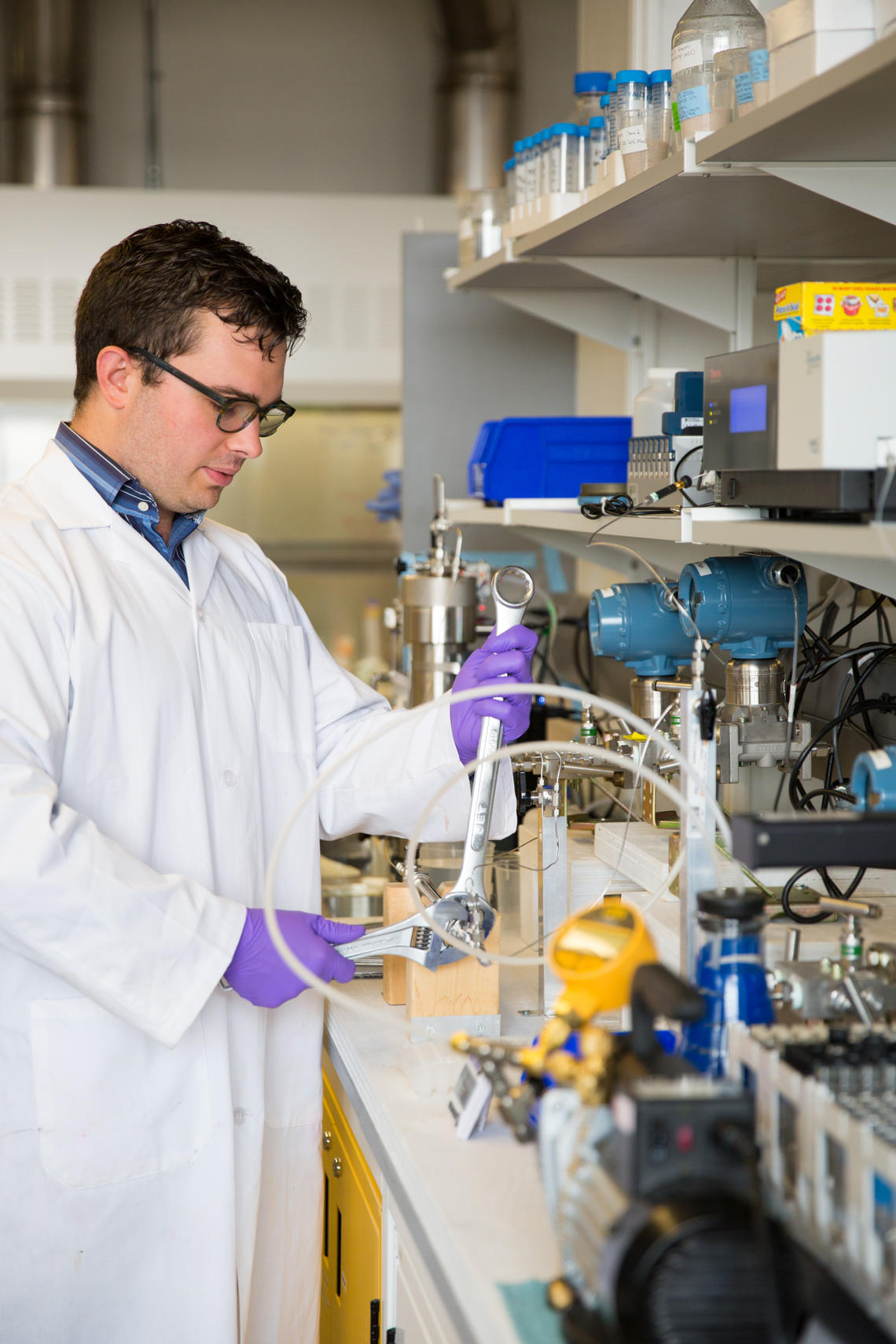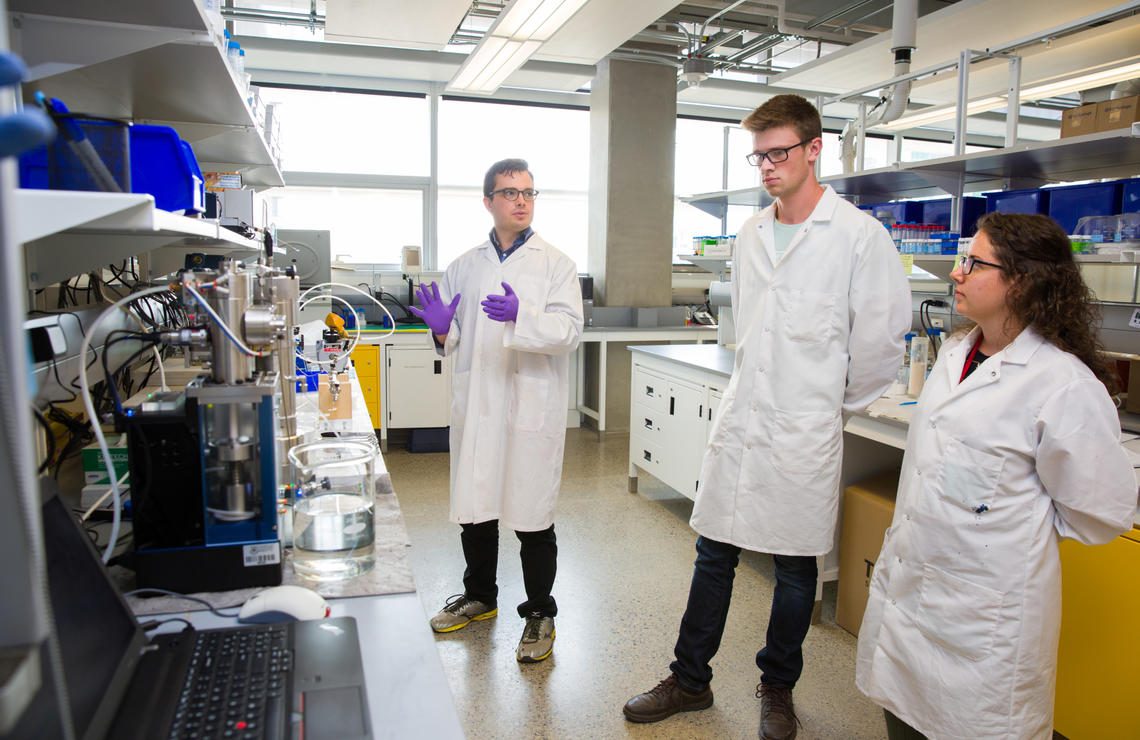
Graduate student Carter Dzuiba researched nanocellulose technology in Steven Bryant’s lab.
Riley Brandt, University of Calgary
Sept. 21, 2017

Graduate student Carter Dzuiba researched nanocellulose technology in Steven Bryant’s lab.
Riley Brandt, University of Calgary
Carter Dziuba conducted energy research this summer in Norway after completing his graduate degree at the University of Calgary, under a new partnership between the university and the Norwegian University of Science and Technology (NTNU). He worked with Reidun Aadland, a PhD student at NTNU who has twice come to UCalgary, where she collaborated with Dziuba on his research investigating nano-sized particles for enhanced oil recovery.
“My research exchange for three months with NTNU allowed me broader technical and cultural exposure,” Dziuba says. “I received a lot of input from many international colleagues that greatly helped to increase the quality of my research.”
The three-year, $850,000 partnership between the two universities, for advanced research and education focused on carbon storage and enhanced oil recovery, is called CARBEOR.
“As part of our Energy Research Strategy at the University of Calgary, we want to strengthen and expand our position as one of the key players internationally in energy research,” says Steven Bryant, UCalgary’s co-manager of CARBEOR and professor in the Department of Chemical and Petroleum Engineering in the Schulich School of Engineering.
“The problems are so big that we need to be doing our research with other centres of expertise in energy around the world,” says Bryant, Canada Excellence Research Chair in Materials Engineering for Unconventional Oil Reservoirs.
Real-world field training for students
Through CARBEOR, Calgary-based CMC Research Institutes will host a summer field school in 2018 at the Containment Monitoring Institute (CaMI) field research station. CaMI, owned and operated by CMC Research Institutes with operational funding from UCalgary, is located in Newell County in southern Alberta.
About 15 to 20 graduate students from UCalgary, Norway and the Netherlands will do research and training on reservoir engineering, geophysics, and monitoring carbon dioxide injected underground at the facility. The research station has state-of-the-art geophysical equipment for tracking CO2 in an underground geological formation and testing new monitoring methods and technologies.

Dzuiba’s research is part of a partnership with the Norwegian University of Science and Technology.
Safe and permanent geological storage is a key technology to keep the greenhouse gas of the atmosphere, where it contributes to global warming and climate change.
“The CARBEOR project is to enhance training opportunities and give graduate students an experience in a different environment,” says Don Lawton, project co-manager and professor of geophysics in the Department of Geoscience in the Faculty of Science.
The project “has given rise to a lot of interaction with the Norwegians, because their carbon capture and storage activity is really advancing,” says Lawton, who’s also director of the CaMI research station.
More environmentally friendly oil extraction
Dziuba, for his master’s degree in chemical and petroleum engineering, investigated the potential of nano-sized (about 10,000 times smaller than a strand of human hair) nanocellulose — a forest industry product — as a material to help extract more oil from geological reservoirs.
“The major benefit of nanocellulose is that it could be an environmentally friendly alternative to some of the current chemicals used in petroleum extraction,” he says. “It’s essentially little bits of wood that poses minimal environmental impact.”
His experiment at UCalgary involved building a sand pack flooding apparatus containing porous silica sand, like that found in a sandstone petroleum reservoir, into which a solution of water and nanocellulose was pumped. Dziuba measured the drop in pressure across the sand pack and the concentration of nanocellulose coming out of the apparatus. That told him how well the nanocellulose was flowing through the sand pack and whether it was getting stuck against the sand.
Nanocellulose solutions that flow long distances though an actual petroleum reservoir could reach more oil and increase recovery rates. On the other hand, nanocellulose solutions that get stuck in a reservoir could also be useful in well-drilling operations using drilling mud, for creating a ‘plug,’ called a filter cake, to prevent drilling fluid losses and ensure optimal oil recovery.
Based on his research at UCalgary, Dziuba says nanocellulose looks promising as a drilling mud additive. “From the technical side, it’s too early to say if it’s showing promise for enhanced oil recovery.”
In Norway, Aadland is still continuing her experiments on nanocellulose’s potential for EOR, working with larger core-flooding apparatus that uses actual reservoir rock cores saturated with oil from the North Sea.
Dziuba completed his degree in May and started work this month with Cenovus Energy on a four-year graduate engineering program. He says the CARBEOR partnership “promotes creativity of ideas and experience with a wider range of research applications, which better equips graduates to tackle the modern challenges that industry is facing.”